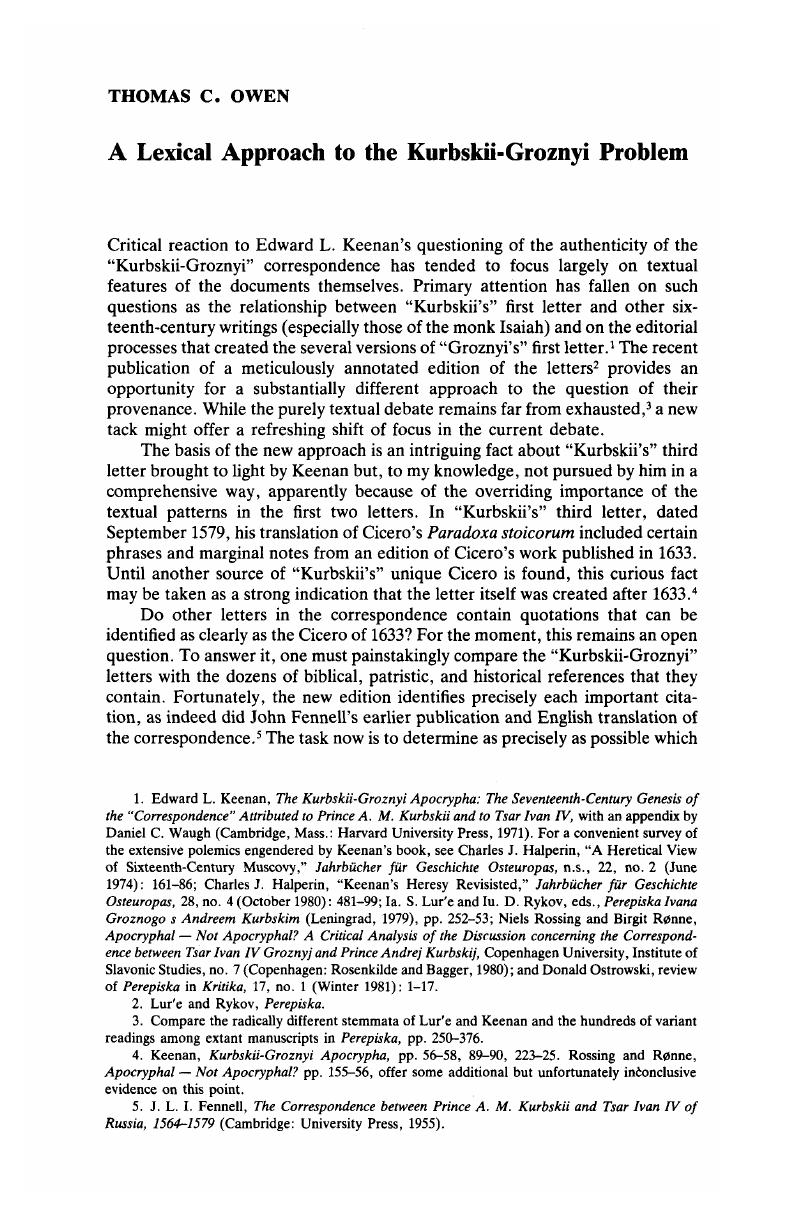No CrossRef data available.
Article contents
A Lexical Approach to the Kurbskii-Groznyi Problem
Published online by Cambridge University Press: 27 January 2017
Abstract

- Type
- Notes and Comment
- Information
- Copyright
- Copyright © Association for Slavic, East European, and Eurasian Studies. 1982
References
1. Keenan, Edward L., The Kurbskii-Groznyi Apocrypha: The Seventeenth-Century Genesis of the “Correspondence” Attributed to Prince A. M. Kurbskii and to Tsar Ivan IV, with an appendix by Daniel C. Waugh (Cambridge, Mass.: Harvard University Press, 1971)CrossRefGoogle Scholar. For a convenient survey of the extensive polemics engendered by Keenan's book, see Charles J. Halperin, “A Heretical View of Sixteenth-Century Muscovy,” Jahrbiicher fiir Geschichte Osteuropas, n.s., 22, no. 2 (June 1974): 161-86; Charles J. Halperin, “Keenan's Heresy Revisisted,” Jahrbiicher fiir Geschichte Osteuropas, 28, no. 4 (October 1980): 481-99; la. S. Lur'e and Rykov, Iu. D., eds., Perepiska Ivana Groznogo s Andreem Kurbskim (Leningrad, 1979), pp. 252–53 Google Scholar; Niels Rossing and Birgit Ronne, Apocryphal — Not Apocryphal? A Critical Analysis of the Discussion concerning the Correspondence between Tsar Ivan TV Grozny] and Prince Andrej Kurbskij, Copenhagen University, Institute of Slavonic Studies, no. 7 (Copenhagen: Rosenkilde and Bagger, 1980); and Ostrowski, Donald, review of Perepiska in Kritika, 17, no. 1 (Winter 1981): 1–17Google Scholar.
2. Lur'e and Rykov, Perepiska.
3. Compare the radically different stemmata of Lur'e and Keenan and the hundreds of variant readings among extant manuscripts in Perepiska, pp. 250-376.
4. Keenan, Kurbskii-Groznyi Apocrypha, pp. 56-58, 89-90, 223-25. Rossing and R0nne, Apocryphal — Not Apocryphal? pp. 155-56, offer some additional but unfortunately in6onclusive evidence on this point.
5. J. L. I. Fennell, The Correspondence between Prince A. M. Kurbskii and Tsar Ivan IV of Russia, 1564-1579 (Cambridge: University Press, 1955).
6. This “lexical criterion,” developed by A. I. Sobolevskii and V. M. Istrin, has been endorsed by a leading Soviet scholar as a crucial means of establishing the place and date of early Slavic translations. Meshcherskii, Nikita A., Istochniki i sostav drevnei slaviano-russkoi perevodnoi pis'- mennosti IX-XV vekov (Leningrad, 1978), p. 21 Google Scholar. Iu. D. Rykov, “K voprosu ob istochnikakh Pervogo poslaniia Kurbskogo Ivanu IV,” Akademiia nauk SSSR, Institut russkoi literatury, Otdel drevnerusskoi literatury, Trudy, 31 (1976): 235-46, noted several biblical passages in “Kurbskii's“ first letter, but made no effort to apply the lexical criterion in a comparison of available editions of the biblical texts.
7. Lur'e and Rykov, Perepiska, p. 22. Portions of the 1499 Bible are reproduced in Gerd Friedhof, Ausziige aus der Gennadius-Bibel (1499), part 1: Der Psalter and part 2: Die Briefe an die Romer, Korinther, Galater und Epheser: Specimina Philologiae Slavicae, vol. 5 and vol. 21 (Frankfurt/ Main, 1974 and 1979, respectively). Microfilm copies of the printed Bibles and Psalters are available at major American libraries in the collection keyed to the reference work by Zernova, Antonina S., Knigi kirillovskoi pechati, izdannye v Moskve v XVI-XVII vekakh: svodnyi katalog (Moscow, 1958)Google Scholar.
8. Proverbs 27:6 and Psalms 61:11, the text of which is the same in the Bibles of 1499,1581, and 1633 and all published Psalters.
9. Lur'e and Rykov, Perepiska, p. 20.
10. Ivan Karataev, Opisanie slaviansko-russkikh knig, napechatannykh kirillovskimi bukvami, 1491-1730, vol. 1: S1491 po 1652 (St. Petersburg, 1878) in Chteniia v obshchestve istorii i drevnostei rossiiskikh, vol. 34, no. 2; Ilarion A., Chistovich, Istoriia perevoda Biblii na russkii iazyk, 2nd ed. (St. Petersburg, 1899)Google Scholar; Aleksei I. Sobolevskii, “Perevodnaia literatura Moskovskoi Rusi XVI-XVII vekov,” Obshchestvo russkogo iazyka i slovesnosti, Sbornik, 74 (1903): 1-460; Orlov, Aleksandr S. Biblioteka Moskovskoi sinodal'noi tipografii, 7 vols, in 2 (Moscow, 1896-1912)Google Scholar; I. E., Evseev, Ocherki po istorii slavianskogo perevoda Biblii (Petrograd, 1916)Google Scholar; Bel'chikov, N. F., comp., Spravochnik- ukazatel’ pechatnykh opisanii slaviansko-russkikh rukopisei (Moscow and Leningrad, 1963)Google Scholar; Rizhskii, M. I., Istoriia perevodov Biblii v Rossii (Novosibirsk, 1978)Google Scholar; and many others cited in Meshcherskii's useful textbook.
11. See Rossing and R0nne, Apocryphal — Not Apocryphal?, almost all of which deals with “Kurbskii's” first letter. Two interesting lexical discussions concern several phrases in this letter that resemble passages in the preface to the Apostol (Acts and Epistles) printed in L'vov in 1574 and in “Kurbskii's” preface to the collection of sermons by St. John Chrysostom entitled Novyi Margarit (ibid., pp. 82, 114-15, and 123-26). On the latter question, see also Ostrowski's review oiPerepiska in Kritika. Rossing and R0nne mention in passing an index to Muscovite manuscripts and the relationship between “Groznyi's” first letter and various chronicles ﹛Apocryphal — Not Apocryphal?, pp. 46, 51, and 148-^9).
12. Drevnii slavianskii perevod Apostola i ego sud'by do 15 veka; opyt issledovaniia iazyka i teksta slavianskogo perevoda Apostola po rukopisiam XII-XV vekov (Moscow, 1879), for example pp. 202-19, 238-39, and 245-54 on Romans 2 and 3.
13. See, for example, Chrysostom's Homilies 7 and 8 on the Epistles to Timothy, , in Nicene and Post-Nicene Fathers, vol. 13 (New York, 1889)Google Scholar.
14. Migne, J.-P., ed., Patrologiae cursus completus … , Series Latina, vol. 17 (Paris, 1879), col. 720Google Scholar. According to Fennell, p. 35, Ambrose did not exist in a medieval Slavic translation; and according to Sobolevskii, p. 281, Kurbskii himself first translated Ambrose's works into Slavic.
15. Migne, Patrologiae cursus completus … , Series Graeca, vol. 36 (Paris, 1853), col. 351.
16. Lur'e and Rykov, Perepiska, n. 91, p. 395; n. 100, p. 399.
17. I. Duichev, “Vizantiia i vizantiiskaia literatura v poslaniiakh Ivana Groznogo,” Trudy, 15 (1958): 174. Duichev's article contains a wealth of pertinent bibliographical information, although it does not represent a lexical study to determine the authenticity of “Groznyi's” letters (ibid., pp. 159-76).
18. Fennell, Correspondence, p. 130; Lur'e and Rykov, Perepiska, p. 400, n. 103.
19. Halperin's characterization of the Kurbskii-Groznyi debate as one of “the many unresolved and unresolvable divisions of opinion which dot the landscape of scholarship” (“Heresy Revisited,“ p. 499) strikes me as excessively relativistic.




